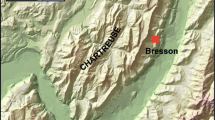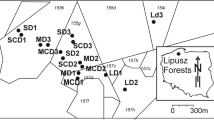Abstract
Pinus wood remains some 7,400 years old are abundantly preserved near the base of eroding peat at Clashgour, west of Loch Tulla on Rannoch Moor in western Scotland. Measurements are presented of the orientations of root systems in 42 in situ stumps, the direction of fall in 27 fallen trunks and the orientation (where direction of fall cannot be defined) in 40 fallen trunks. There are statistically significant orientations in the root systems, which suggests that the root structure of the trees had responded to stress from westerly winds. However, despite this the orientations and directions of fall in tree trunks, also statistically significant, show that many trees were probably blown over by strong westerly winds. The data suggest that increased precipitation and accelerated paludification are less likely explanations for tree loss at this site than a sudden demise through wind-throw.





Similar content being viewed by others
References
Allen JRL (1992) Trees and their response to wind: mid Flandrian strong winds, Severn Estuary and inner Bristol Channel, southwest Britain. Phil Trans R Soc Lond B338:335–364
Antonsson K, Brooks SJ, Seppa H, Telford RJ, Birks HJB (2006) Quantitative palaeotemperature records inferred from fossil pollen and chironomid assemblages from Lake Gilltjarnen, northern central Sweden. J Quat Sci 21:831–843
Bennett KD (1984) The post-glacial history of Pinus sylvestris in the British Isles. Quat Sci Rev 3:133–155
Bennett KD (1995) Postglacial dynamics of pine (Pinus sylvestris) and pinewoods in Scotland. In: Aldhous JR (ed) Our Pinewood Heritage. Forestry Commission, The Royal Society for the Protection of Birds and Scottish Natural Heritage, Edinburgh, pp 22–39
Birks HH (1972) Studies in the vegetational history of Scotland. II. Two pollen diagrams from the Galloway Hills, Kirkcudbrightshire. J Ecol 60:183–217
Birks HH (1975) Studies in the vegetational history of Scotland. IV. Pine stumps in Scottish blanket peats. Phil Trans R Soc Lond B270:181–226
Birks HJB (1987) The vegetational context of Mesolithic occupation on Oronsay and adjacent areas. In: Mellars P (ed) Excavations on Oronsay. Prehistoric human ecology on a small island. Edinburgh University Press, Edinburgh, pp 71–77
Bridge MC, Haggart BA, Lowe JJ (1990) The history and palaeoclimatic significance of subfossil remains of Pinus sylvestris in blanket peats from Scotland. J Ecol 78:77–99
Bunting MJ, Tipping R (2004) Complex hydroseral vegetation succession and ‘dryland’ pollen signals: a case study from north-west Scotland. Holocene 14:53–63
Daniell JRG (1997) The late-Holocene palaeoecology of Scots Pine (Pinus sylvestris L.) in NW Scotland. Unpublished Ph.D. Thesis, University of Durham
Dubois AD, Ferguson DK (1985) The climatic history of pine in the Cairngorms based on radiocarbon dates and stable isotope analysis, with an account of the events leading up to its colonization. Rev Palaeobot Palynol 46:55–80
Epstein S, Yapp CJ (1977) Isotope tree thermometers. Nature 266:477–478
Froyd CA (2005) Fossil stomata reveal early pine presence in Scotland: implications for postglacial colonization analyses. Ecology 86:579–586
Froyd CA, Bennett KD (2006) Long-term ecology of native pinewood communities in East Glen Affric, Scotland. Forestry 79:279–293
Gear AJ (1989) Holocene vegetational history and the palaeoecology of Pinus sylvestris in Northern Scotland. Unpublished Ph.D. Thesis, University of Durham
Gear AJ, Huntley B (1991) Rapid changes in the range limits of Scots Pine 4,000 years ago. Science 251:544–547
Huntley B, Daniell RG, Allen JRM (1997) Scottish vegetation history: the Highlands. Bot J Scotl 49:163–176
Lamb HH (1964) Trees and climatic history in Scotland. Quart J R Met Soc 90:382–394
Leuschner HH, Bauerochse A, Metzler A (2007) Environmental change, bog history and human impact around 2900 B.C. in NW Germany: preliminary results from a dendroecological study of a sub-fossil pine woodland at Campemoor, Dümmer Basin. Veget Hist Archaeobot 16:183–195
Linton DL (1951) Watershed breaching by ice in Scotland. Trans Inst Br Geogr 15:1–15
Lowe JJ (1993) Isolating the climatic factors in early- and mid-Holocene palaeobotanical records from Scotland. In: Chambers FM (ed) Climate change and human impact on the landscape. Chapman & Hall, London, pp 67–82
Moore PD (1993) The origin of blanket mire, revisited. In: Chambers FM (ed) Climate change and human impact on the landscape. Chapman & Hall, London, pp 217–224
Nicoll BC, Ray D (1996) Adaptive growth of tree root systems in response to wind action and site conditions. Tree Physiol 16:891–898
O’Sullivan PE (1976) Pollen analysis and radiocarbon dating of a core from Loch Pityoulish, eastern Highlands of Scotland. J Biogeogr 3:293–302
Quine C (2003) Wind as a disturbance agent and its implications for forest landscape patterns at Glen Affric. In: Bell S (ed) The potential of applied landscape ecology to forest design planning. Forestry Commission, Edinburgh, pp 55–62
Roy M (1997) The highlands and islands of Scotland. In: Wheeler D, Mayes J (eds) Regional climates of the British Isles. Routledge, London, pp 228–253
Smout TC, MacDonald AR, Watson F (2005) A history of the native woodlands of Scotland, 1500–1920. Edinburgh University Press, Edinburgh
Tipping R (1996) Microscopic charcoal records, inferred human activity and climate change in the mesolithic of northernmost Scotland. In: Pollard T, Morrison A (eds) The early prehistory of Scotland. Edinburgh University Press, Edinburgh, pp 39–61
Tipping R, Milburn P (2000) The mid-Holocene charcoal fall in southern Scotland: spatial and temporal variability. Palaeogeogr Palaeoclimatol Palaeoecol 164:193–209
Tipping R, Davies A, Tisdall E (2006) Long-term woodland dynamics in West Glen Affric, northern Scotland. Forestry 79:351–359
Tipping R, Ashmore P, Davies AL, Haggart BA, Moir A, Newton A, Sands R, Skinner T, Tisdall E (2007) Prehistoric Pinus woodland dynamics in an upland landscape in northern Scotland: the roles of climate change and human impact. Veget Hist Archaeobot. doi:10.1007/s00334-007-0120-z
Walker MJC (1984) A pollen diagram from St. Kilda, Outer Hebrides, Scotland. New Phytol 97:99–113
Ward RGW, Haggart BA, Bridge MC (1987) Dendrochronological studies of bog pine from the Rannoch Moor area, western Scotland. In: Ward RGW (ed) Applications of tree-ring studies. BAR, Oxford, pp 215–225
Willis KJ, Bennett KD, Birks HJB (1998) The late Quaternary dynamics of pines in Europe. In: Richardson DM (ed) Ecology and biogeography of Pinus. Cambridge University Press, Cambridge, pp 107–121
Wilson BF (1975) Distribution of secondary thickening in tree root systems. In: Torrey JG, Clarkson DT (eds) The development and function of roots. Academic Press, London, pp 197–219
Acknowledgments
Many thanks are due to my project students at Stirling University (Grant Alston, Caron Blacklock, Andrew Cartwright and Ryan Sweeney) for obtaining some of the measurements presented here.
Author information
Authors and Affiliations
Corresponding author
Additional information
Communicated by M. O'Connell.
Rights and permissions
About this article
Cite this article
Tipping, R. Storminess as an explanation for the decline of pine woodland ca. 7,400 years ago at Loch Tulla, western Scotland. Veget Hist Archaeobot 17, 345–350 (2008). https://doi.org/10.1007/s00334-008-0145-y
Received:
Accepted:
Published:
Issue Date:
DOI: https://doi.org/10.1007/s00334-008-0145-y




